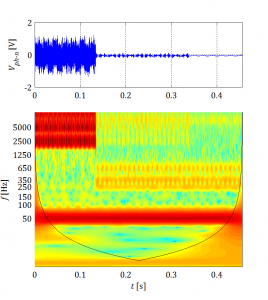Harmonics were always of special concern in power system studies. In the past the power system was comprised of mainly passive components with relatively linear operating range as well as synchronous generators. Harmonic analysis of such systems is state-of-the art right now. Nowadays modern power systems include more and more power electronic components than in the past. The most significant power electronic components are different types of flexible alternating current transmission system (FACTS) devices such as static synchronous compensator (STATCOM) or static var compensator (SVC). Also renewable energy sources (e.g. wind turbines, photo voltaic installations, tidal steam generators) as well as high-voltage, direct current (HVDC) electric power transmission systems become more popular. Power electronic equipment in modern power systems is obviously a source of additional harmonic components not seen previously. On the other hand, the application of advanced and fast control in grid-connected power converters introduces possibility of control higher than the fundamental frequency components. Appropriately used power electronics can definitely improve the quality of power.
To show how harmonics have being been more and more important in electrical engineering and power system studies a popular electrical engineering database was investigated. Institute of Electrical and Electronics Engineers (IEEE) is considered by many as one of the biggest professional association gathering electrical and electronics engineers from many fields. The association has an extended digital library comprising more than 3 million technical and scientific documents. Unfortunately access to the documents if not open for all interested and therefore knowledge sharing is limited especially for small research units all around the world.
Analysis of such database form harmonic and wind power research perspective can give a good overview how advancement of technology in both areas has been developed in the space of the years. At the begging let us see how publications regarding harmonics have appeared.
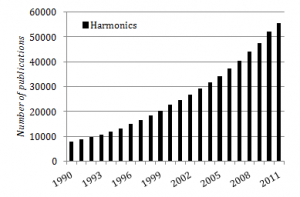
The first paper regarding harmonics in the ieee database is from 1899 but the most significant development within the area of harmonics started in late 80's. In Figure 1 one can see that the interest of harmonics is still increasing. Up to now there are more than 55000 of publications only about harmonics. Obviously harmonic analysis can be applied in many fields of electrical engineering. Let us additionally see how in the same period the interest in wind turbines and wind farms development increased.
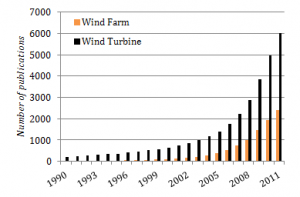
In case of research associated with harmonics the tendency is rather linear, but regarding both wind turbines and wind farms there is an exponential growth of interest directly reflected in number of publications. This tendency can be easily seen in Figure 2. This general interest in wind power can be also easily seen in increasing number of commercial projects. Therefore harmonics analysis in this particular field of electrical engineering seems to be important also from market tendencies perspective.
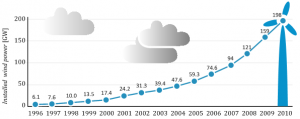
Figure 3 shows that increasing interest of wind power technology is correlated with increasing world capacity of wind power [1]. As it can be concluded this tendency will be increasing within next few years. Therefore new research projects are required to extend knowledge and experience in the area of renewable energy sources. This also implies an increasing interest of harmonic research within this area of power industry. As it can be seen also in Figure 2 wind turbine studies are more popular than wind farm. It seems to be a natural way of research. Although it also indicates that there is much less experience with wind farm analysis as a whole system comprising many wind turbines and other components. The first observed publication in the IEEE database regarding wind turbines is from 1958 but regarding wind farms is much later (1982). Even less experience is gained in offshore wind power solutions. This field is newbie (first mention in 2000) in comparison to onshore installations. Anyway nowadays knowledge sharing capability and technology development allow deriving knowledge from other fields and continuous improvement.
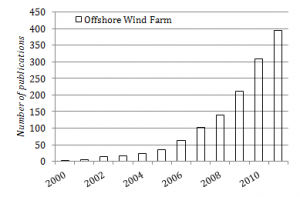
In Figure 4 one can see even clearer tendency of exponential growth of interest and research within the field of offshore wind farms. I hope that based on presented above facts one can see that there is a great interest in offshore wind power solutions which creates new challenges to the wind industry from harmonic analysis perspective.
[1] J. L. Sawin and E. Martinot, "Renewables 2011 Global Status Report," Renewable Energy Policy Network for the 21st Century, Annual Report, 2011.

